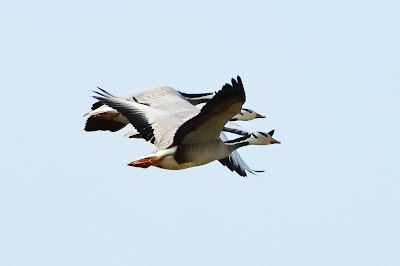 |
| A Pair of Bar-headed Geese take to the air |
Being a self-professed photographer of wild birds, I would like to add that nothing can be more exciting, challenging and tricky than photographing birds in flight! More often than not you return home with barely a handful of photographs, some of them so bad that you might as well remove them from your memory card. I have often faced problems with the lighting, especially in the mornings because of fog and mist. There have been times when I have had to wade into streams, muck and mud, hopefully not falling down with my cameras. At other times, I have had to ride my bike through all that sticky mud, no wonder, with my heart in my mouth lest I should stop in the middle of the slush - I have wondered so often if I should not buy myself a pair of gumboots!
 |
| Bar-headed Geese fly with an under-construction pylon in the background. |
There are, however, a few occasions when you return home, muddied till your eyes, but with a "card full" of usable photographs. And then, the post-editing takes away most of your day. The results, however, might have been worth it and I am sharing some of them in this post (this time without the watermark as converting the JPEG into the paint format drastically reduces the quality). A few tips for photographing birds in flight include using a reasonable zoom lens, in my case a Canon USM IS-II 70-300 mm and a Canon IS-II 55-250 mm lens. I do have a couple of tripods but have realised that they are more a burden than a help, that is if you are carrying two lenses, two DSLRs and yourself on top! I believe in carrying as little weight as possible and not being hampered by a tripod since some of the best photographs of birds in flight require panning.
 |
| Bar-headed Geese fly with apartment blocks in the background. |
My favourite settings for photographing birds in flight include a shutter speed of 1600/sec to 2000/sec, an f-stop range of 5.6 to 8 though it might go a bit higher depending on the lighting, and of course an ISO rating of 100 to 800. For metering, I use centre-weighted or evaluative metering. However, for the photographs I have shared in this post I have made use of evaluative metering.
 |
| Bar-headed Geese take to the air at the Basai Wetland. |
Some of the trickiest photographs of birds in flight are those taken when they start to fly. Gauging their intentions and guessing the exact moment they take off from the ground is most crucial. I try to get as close to them, without of course alarming them. For this, I make sure that I wear clothes that meld into the background, and I never ever walk towards them in a straight line. I often crouch on the ground and then advance a few steps and then crouch again. This way, you get close enough to the birds to take some amazing snaps of them taking off into the air. The first photograph in the post is an example of what I mean. Of course, having photographed Bar-headed Geese for quite a few years now, I have learned to recognise the sounds they make before they take off.
 |
| Bar-headed Geese take off en-masse. |
Once the birds are off the ground and they gain sufficient altitude, it is less of a task to photograph them. This is because their relative speed becomes easier to handle.
 |
| A Pair of Bar-headed Geese at the Basai Wetland |
 |
Bar-headed Geese wheeling around in the sky.
|







No comments:
Post a Comment